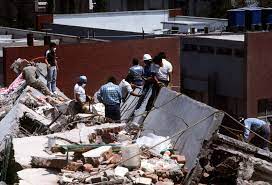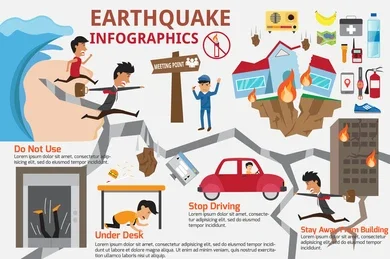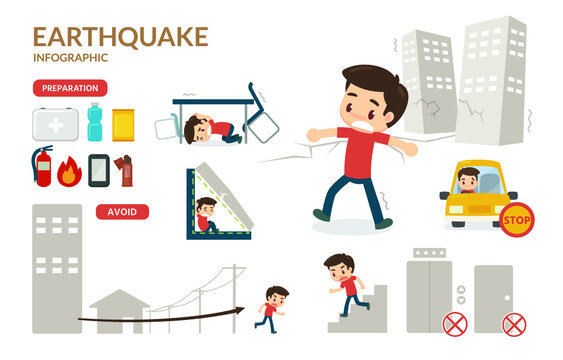Unraveling Earth’s Tremors

Earthquakes, the sudden and intense shaking of the ground, are natural phenomena that can have catastrophic consequences. The recent magnitude 7.5 earthquake near the Noto Peninsula in Japan on the first day of 2024 serves as a stark reminder of the Earth’s dynamic nature. This event prompts us to delve into the interconnectedness of tectonic plates, the science behind earthquakes, and the efforts made in forecasting and mitigating their impact.
Earth’s Tectonic Plates

The Earth’s lithosphere is divided into several massive plates that float on the semi-fluid asthenosphere beneath them. These tectonic plates are in constant motion, albeit at a slow pace, shaping the Earth’s surface over millions of years. Understanding how these plates interact is crucial for comprehending seismic activities.
Earth’s Plate Boundaries
- Divergent Boundaries:
At these boundaries, such as mid-ocean ridges, plates move away from each other. This movement can create rifts and volcanic activity.
- Convergent Boundaries
Plates collide at convergent boundaries, leading to subduction where one plate descends beneath the other. Alternatively, mountains may form as a result of the collision.
- Transform Boundaries
At transform boundaries, plates slide past each other horizontally, causing earthquakes along the fault lines.
The Ring of Fire
A significant portion of earthquake activity occurs along the Pacific Ring of Fire, where several tectonic plates meet. The Indian Plate, in particular, plays a vital role in seismic events due to its convergence with the Eurasian Plate.
READ MORE : GOOGLE PASSKEYS AND DEMISE OF TRADITIONAL PASSWORDS
Indian Plate Dynamics
The Indian Plate, a major tectonic plate, has been a focal point of seismic activity due to its convergence with the Eurasian Plate. Understanding the dynamics of the Indian Plate is crucial for predicting and preparing for future earthquakes Subduction Zones
The Himalayan region, formed by the ongoing collision between the Indian and Eurasian Plates, is prone to seismic activities. Subduction zones, where one plate descends beneath another, create stress and eventually lead to earthquakes.
Intraplate Earthquakes
Recent studies highlight the occurrence of intraplate earthquakes, like the one near the Noto Peninsula, challenging traditional notions that earthquakes are solely a result of subduction.
The Noto Peninsula Earthquake (2024)

On the first day of 2024, Japan experienced a magnitude 7.5 earthquake near the Noto Peninsula, showcasing the complexity of seismic events.
Variability in Measurements

The U.S. Geological Survey (USGS) and the Japanese Meteorological Agency (JMA) recorded varying magnitudes, emphasizing the challenges in precisely measuring earthquakes due to different sensors and methodologies.
Unconventional Nature: Earthquake Swarm

The Noto Peninsula earthquake distinguished itself by being part of an “earthquake swarm,” a series of seismic events not associated with traditional subduction zones. MIT’s William Frank noted this as a unique characteristic of the quake.
Warning Systems and Preparedness
Efforts to minimize the impact of earthquakes involve advanced warning systems and community preparedness.
Tsunami Warnings

Prompt issuance of tsunami warnings is critical. In the Noto Peninsula earthquake, a major tsunami warning was initially declared, showcasing the importance of quick response and eventual downgrading to an advisory based on real-time data.
Nuclear Power Plant Resilience
The earthquake tested the resilience of the Shika nuclear power plant, emphasizing the importance of designing critical infrastructure to withstand seismic events.
What to Do During an Earthquake?

In the face of an earthquake, it is crucial to follow safety guidelines to minimize harm and enhance survival rates. Here are some methods to consider:
Drop, Cover, and Hold On
- Drop: Get down to your hands and knees to prevent being knocked over.
- Cover: Take cover under a sturdy piece of furniture or protect your head and neck with your arms.
- Hold On: Hold on to your shelter until the shaking stops, and it is safe to move.
Stay Indoors
If you are indoors, stay there. Avoid doorways and windows, and if possible, take cover under a table or desk.
Stay Away from Objects
Keep a safe distance from heavy furniture, glass, and other objects that may pose a threat during shaking.
Evacuate if Necessary
If you are in a high-rise building or near the coast and a tsunami warning is issued, follow evacuation routes promptly.
Be Prepared
Have an emergency kit ready, including essentials like water, non-perishable food, a flashlight, and first aid supplies.
Safety Drills

Regularly practice earthquake drills with your family or colleagues to ensure everyone knows what to do during an earthquake. Familiarity with safety procedures can significantly reduce panic and improve overall response effectiveness.
Earthquakes are complex geological phenomena influenced by the intricate dance of tectonic plates. Understanding these dynamics, especially in regions like the Indian Plate, is crucial for effective prediction and mitigation. As we continue to witness seismic events, ongoing research and advancements in warning systems are paramount in ensuring the safety and resilience of communities around the world. Following proper safety measures during an earthquake, including regular drills, is vital for individual and community well-being.
Previous Article Details:
- BUDGET RULE DOMINANACE: ACHIEVING FINANCIAL MASTERY WITH THE ULTIMATE GUIDE TO THE 50/30/20 RULE
- GOOGLE PASSKEYS AND DEMISE OF TRADITIONAL PASSWORDS: REVOLUTIONIZING SECURITY AND EXPLORING THE 4 MAJOR PERKS OF PASSKEYS
- 60TH MUNICH CONFERENCE: INDIA’S EXTERNAL AFFAIR MINISTER S.JAISHANKAR ASTOUNDING BALANCING ACT
- Japan’s Upbeat Economic Transformation Following UK: Germany Secures Third-largest Economy Position
- Love is in the air! Valentine’s Day: A Celebration on February 14